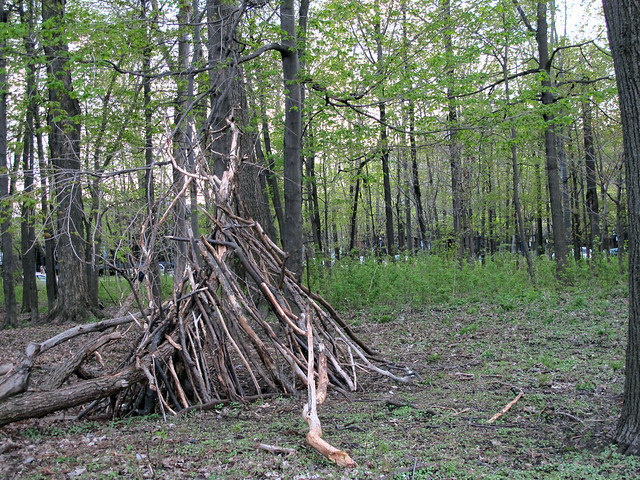Between the tree trunks, I can spot the traffic light at the corner of Cote-Saint-Catherine road. The outline of apartment buildings half a block away is hardly subtle, yet I still have the distinct impression that I am in a forest. It must be the wildness of the forest floor, where heaps of scraggly branches tangle on the ground and a bushy green layer of underbrush is pushing up through the whispy remains of last year’s fallen leaves.
Mackenzie-King Park in Côte-des-Neiges, is one of the few neighbourhood parks that’s got a bonafide patch of woods. It may only be the size of a city block, but something very important has happened here: someone has built a fortress.
Why is this of such tantamount important? Take a look at what the experts have to say.
Louise Chawla is a professor of planning and urban design, and coordinated Growing up in Cities, a UNESCO program that seeks to involve children in evaluating and improving urban environments in over 50 countries worldwide. Chawla argues that a responsive environment can help prepare young people to participate as citizens:
“For ball play, rollerblading, or cycling, nothing is better than hard, flat surfaces. For most other actions, children need a more malleable world. Natural elements are particularly rich in the effects they offer, and what is more, although they are predictable to a point, they also offer intriguing surprises. Water flows and splashes in fluid forms. Soft earth can be dug and moulded in infinite iterations. Every rock has a different heft and shape for building. Every rotting log reveals a different universe of insect life inside. Convivial city streets and public spaces offer similarly responsive settings for social interactions, which – like natural elements – never do exactly the same thing twice…
“Adults’ accounts of special childhood places show that they tend to be on the margins of the adult world, where children can find freedom to take risks and prove themselves, get dirty, make and unmake play worlds with abandon and interact intensively both with the physical world and with friends (Cooper Marcus 1978; Goodenough 2003). These sites include tree houses, play forts, creek banks, and overgrown lots, colonised by children on the edge of the adult world in both cities and rural areas. They also include public spaces where children feel welcomed by adults…” (Chawla, 2008).
…
“This reciprocity between self-produced action and environmental events lies at the heart of the development of a sense of competence (Bandura 1997). For this reason, Fuglesang and Chandler (1997) argue that responsive early childhood programmes and parent training to increase interactive experiences of this kind are important precursors to children’s readiness for more formal types of participation. In research with adolescents and adults, this experience of self-efficacy promotes learned optimism (Seligman and Csikszentmihalyi 2000) and life satisfaction (Ryan and Deci 2001). As Bandura (1997) has noted, to inspire people to continue working towards goals, nothing is as motivating as ‘mastery experiences’ of their own capability.” (Chawla, 2008, emphasis added).
Which is all a rather academic way of saying that surely, this is the way children were meant to play?
—–
Source: Chawla, L. (2008). Participation and the Ecology of Environmental Awareness and Action. In: Participation and Learning. Eds: Reid, A, Jensen, B. B. Nikel, J. et Simovska, V. Springer. (PDF)



2 comments
Wow! I say, not only is it the way that children were meant to play, but the benefits as precursors to formal types of participation are phenomenal! Finding freedom to take risks, and to make and unmake playworlds…. This reminds me of my own childhood: A little clump of bushes, smaller than this wooded city-block, was a place where friends, some imaginary, came for tea, served in leafy cups with twiggy utensils. Crossing the large park to go to the Library and on the way back at night making a fire to roast potatoes. That was an urban adventure that we had thanks to my father. He’ll be 92 in June!
McKenzie King Park was created around 1955 from the remnants of the vast fields and forests of earlier generation farm and vegetable garden owners such as Desmarchais whose house (1723-1928) was located on Cote des Neiges Road near de la Peltrie. See the photo on Flickr.com. In the mid-1950s we kids would pick and eat from the last remaining raspberry and logan berry bushes in the forest. Not a trace of those bushes exists today. Later, despite the fact that between 1961 and 1971 the existing forest in McKenzie King Park had been fenced-in, presumably to protect newly-planted trees, the removal of that fence has since enabled thoughtless residents and vandals to damage and destroy what was left. Indeed, I often witnessed machete-wielding, newly-arrived residents of the neighbouring streets chopping down saplings to feed the fires of their weekend family barbecue get-togethers–a social phenomenon which had previously never been permitted. Piles of burned charcoal and litter continue to plague the nearby park fields and recent, half-hearted attempts by the city to clean up the damage by removing some dead trees and branches have not resulted in a user-friendly, nor pleasant green space environment for this sector of the district of Cote des Neiges. When you consider that other parks in the city have been properly planned and maintained–such as for example, Parc Jeanne Sauve in Ahuntsic–McKenzie King Park is a sad reminder of the indifference and neglect that can happen when priorities are transferred elsewhere.